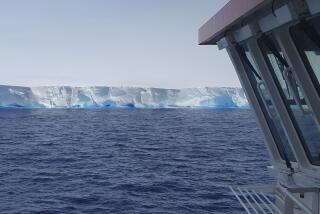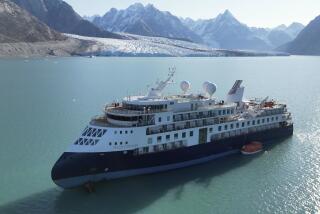Liner That Struck Iceberg Reportedly Going Too Fast
- Share via
OSLO — Norwegians involved in the rescue of hundreds of passengers from a Soviet liner said Wednesday that it was going too fast for safety when it rammed into an iceberg and took on water in Arctic seas.
The head of the medical team aboard a Norwegian rescue ship said some of the Soviet crew were drunk at the time. Others involved in the rescue contradicted him.
Ships and helicopters took the 575 passengers, all but a dozen of them West Germans, to shelter on Spitsbergen Island. They were flown Wednesday to Duesseldorf, West Germany, cutting short their pleasure cruise to the land of the midnight sun.
About half of the 378 Soviet crewmen stayed on board to nurse the Maxim Gorky to harbor. The Soviet news agency Tass said sailors plugged the holes in the ship’s bow. It will receive emergency repairs on Spitsbergen, Tass said.
The disabled 25,000-ton vessel was limping under its own power in the Norwegian Sea toward Spitsbergen, about 180 miles east of the accident, Norwegian defense officials said.
Dr. Mads Gilbert, aboard the coast guard cutter Senja when it broke through thick ice to rescue the people, said, “Our impression was that some of the crew were intoxicated.
“We were surprised at the extent of intoxication,” Gilbert told state radio. He said many crew members were too drunk to help operate pumps 12 hours after the accident.
But officers on the Senja said that only members of the catering staff were drunk, Norwegian state radio NRK reported.
Rescued passengers, some of whom spent seven hours in lifeboats at near-freezing temperatures, said they had been offered whiskey and vodka during the ordeal to ward off the cold.
“The German passengers had nothing but praise for the Soviet crew and said nothing about drunken crewmen,” said Spitsbergen Gov. Leif Eldring, who met arriving passengers early Wednesday.
“If the crew had been drunk, the Maxim Gorky would have sunk,” said a Soviet Embassy official in Oslo, speaking on condition of anonymity.
Maritime experts said the ship was moving at 21 m.p.h. when it struck the ice, much faster than it should have sailed in treacherous waters.
“I would hardly have sailed faster than 2 to 3 knots in such ice-clogged water,” said Sigurd Kleiven, captain of the Senja.
The collision tore a gash 20 feet long and four to six inches wide in the bow. The ship took on 18,000 tons of water and was listing badly when the passengers scrambled into lifeboats.
For West German passenger Giesela Rillinger, “It was six hours of nothing but ice floes and the sky. If a storm had come up it would have been all over for us. Six hours of facing death.”
More to Read
Sign up for Essential California
The most important California stories and recommendations in your inbox every morning.
You may occasionally receive promotional content from the Los Angeles Times.













